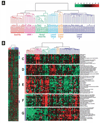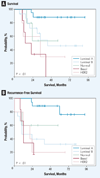Biology, metastatic patterns, and treatment of patients with triple-negative breast cancer - PubMed (original) (raw)
Review
Biology, metastatic patterns, and treatment of patients with triple-negative breast cancer
Carey K Anders et al. Clin Breast Cancer. 2009 Jun.
Abstract
Of the estimated 1 million cases of breast cancer diagnosed annually worldwide, it is estimated that over 170,000 will harbor the triple-negative (estrogen receptor/progesterone receptor/HER2-negative) phenotype. Most, though not all, triple-negative breast cancers will be basal-like on gene expression micorarrays. The basal-like molecular subtype exhibits a unique molecular profile and set of risk factors, aggressive and early pattern of metastasis, limited treatment options, and poor prognosis. Large population-based studies have identified a higher proportion of triple-negative breast tumors among premenopausal African American women, and a suggestion that increased parity, younger age at first-term pregnancy, shorter duration of breast feeding, and elevated hip-to-waist ratio might be particular risk factors. When BRCA1 mutation carriers develop breast cancer, it is usually basal-like; given the central role of BRCA1 in DNA repair, this could have profound therapeutic implications. When diagnosed, triple-negative breast cancers illustrate preferential relapse in visceral organs, including the central nervous system. Although initial response to chemotherapy might be more profound, relapse is early and common among triple-negative breast cancers compared with luminal breast cancers. The armamentarium of "targeted therapeutics" for triple-negative breast cancer is evolving and includes strategies to inhibit angiogenesis, epidermal growth factor receptor, and other kinases. Finally, the positive association between triple-negative breast cancer and BRCA mutations makes inhibition of poly(adenosine diphosphate-ribose) polymerase-1 an attractive therapeutic strategy that is in active study.
Figures
Figure 1
Gene Expression Patterns of 85 Experimental Breast Tissues (78 Carcinomas, 3 Benign Tumors, and 4 Normal Tissues) Analyzed via Hierarchical Clustering Using the 476-cDNA Intrinsic Gene Set Reproduced with permission. Sørlie T, Perou CM, Tibshirani R, et al. Gene expression patterns of breast carcinomas distinguish tumor subclasses with clinical implications. Proc Natl Acad Sci U S A 2001; 98:10869-74. Copyright 2001 National Academy of Sciences, U.S.A.
Figure 2
Prognosis as Defined via Intrinsic Subtypes Reproduced with permission. Sø rlie T, Perou CM, Tibshirani R, et al. Gene expression patterns of breast carcinomas distinguish tumor subclasses with clinical implications. Proc Natl Acad Sci U S A 2001; 98:10869-74. Copyright 2001 National Academy of Sciences, U.S.A.
Similar articles
- Triple negative breast cancer: from molecular portrait to therapeutic intervention.
Carotenuto P, Roma C, Rachiglio AM, Botti G, D'Alessio A, Normanno N. Carotenuto P, et al. Crit Rev Eukaryot Gene Expr. 2010;20(1):17-34. doi: 10.1615/critreveukargeneexpr.v20.i1.20. Crit Rev Eukaryot Gene Expr. 2010. PMID: 20528735 Review. - Triple-negative breast cancer: current state of the art.
Rastelli F, Biancanelli S, Falzetta A, Martignetti A, Casi C, Bascioni R, Giustini L, Crispino S. Rastelli F, et al. Tumori. 2010 Nov-Dec;96(6):875-88. Tumori. 2010. PMID: 21388048 Review. - Basal cytokeratin and epidermal growth factor receptor expression are not predictive of BRCA1 mutation status in women with triple-negative breast cancers.
Collins LC, Martyniak A, Kandel MJ, Stadler ZK, Masciari S, Miron A, Richardson AL, Schnitt SJ, Garber JE. Collins LC, et al. Am J Surg Pathol. 2009 Jul;33(7):1093-7. doi: 10.1097/PAS.0b013e31819c1c93. Am J Surg Pathol. 2009. PMID: 19390427 - Directed therapy of subtypes of triple-negative breast cancer.
Carey LA. Carey LA. Oncologist. 2011;16 Suppl 1:71-8. doi: 10.1634/theoncologist.2011-S1-71. Oncologist. 2011. PMID: 21278443 - Triple negative breast cancer: unmet medical needs.
Pal SK, Childs BH, Pegram M. Pal SK, et al. Breast Cancer Res Treat. 2011 Feb;125(3):627-36. doi: 10.1007/s10549-010-1293-1. Epub 2010 Dec 15. Breast Cancer Res Treat. 2011. PMID: 21161370 Free PMC article. Review.
Cited by
- A DNA repair BRCA1 estrogen receptor and targeted therapy in breast cancer.
Ratanaphan A. Ratanaphan A. Int J Mol Sci. 2012 Nov 14;13(11):14898-916. doi: 10.3390/ijms131114898. Int J Mol Sci. 2012. PMID: 23203101 Free PMC article. Review. - Preclinical antitumor activity of ST7612AA1: a new oral thiol-based histone deacetylase (HDAC) inhibitor.
Vesci L, Bernasconi E, Milazzo FM, De Santis R, Gaudio E, Kwee I, Rinaldi A, Pace S, Carollo V, Giannini G, Bertoni F. Vesci L, et al. Oncotarget. 2015 Mar 20;6(8):5735-48. doi: 10.18632/oncotarget.3240. Oncotarget. 2015. PMID: 25671299 Free PMC article. - Application of Electrospun Drug-Loaded Nanofibers in Cancer Therapy.
Yang Y, Zhang R, Liang Z, Guo J, Chen B, Zhou S, Yu D. Yang Y, et al. Polymers (Basel). 2024 Feb 12;16(4):504. doi: 10.3390/polym16040504. Polymers (Basel). 2024. PMID: 38399882 Free PMC article. Review. - β1 Integrin as a Prognostic and Predictive Marker in Triple-Negative Breast Cancer.
Yin HL, Wu CC, Lin CH, Chai CY, Hou MF, Chang SJ, Tsai HP, Hung WC, Pan MR, Luo CW. Yin HL, et al. Int J Mol Sci. 2016 Aug 31;17(9):1432. doi: 10.3390/ijms17091432. Int J Mol Sci. 2016. PMID: 27589736 Free PMC article. - Tumor cell lysate-loaded immunostimulatory spherical nucleic acids as therapeutics for triple-negative breast cancer.
Callmann CE, Cole LE, Kusmierz CD, Huang Z, Horiuchi D, Mirkin CA. Callmann CE, et al. Proc Natl Acad Sci U S A. 2020 Jul 28;117(30):17543-17550. doi: 10.1073/pnas.2005794117. Epub 2020 Jul 15. Proc Natl Acad Sci U S A. 2020. PMID: 32669433 Free PMC article.
References
- Perou CM, Sørlie T, Eisen MB, et al. Molecular portraits of human breast tumours. Nature. 2000;406:747–752. - PubMed
- Swain SM. Triple-negative breast cancer: metastatic risk and role of platinum agents. Paper presented at: 44th Annual Meeting of the American Society of Clinical Oncology; May 30-June 3, 2008; Chicago, IL.
- Nielsen TO, Hsu FD, Jensen K, et al. Immunohistochemical and clinical characterization of the basal-like subtype of invasive breast carcinoma. Clin Cancer Res. 2004;10:5367–5374. - PubMed
Publication types
MeSH terms
Substances
LinkOut - more resources
Full Text Sources
Other Literature Sources
Medical
Research Materials
Miscellaneous

